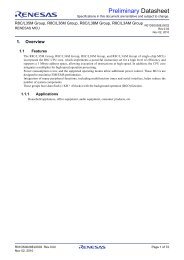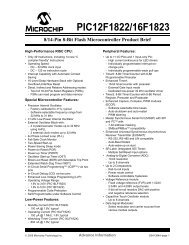xmega a3u - Elfa
xmega a3u - Elfa
xmega a3u - Elfa
You also want an ePaper? Increase the reach of your titles
YUMPU automatically turns print PDFs into web optimized ePapers that Google loves.
XMEGA A3U<br />
10. System Clock and Clock options<br />
10.1 Features<br />
10.2 Overview<br />
• Fast start-up time<br />
• Safe run-time clock switching<br />
• Internal oscillators:<br />
– 32MHz run-time calibrated and tuneable oscillator<br />
– 2MHz run-time calibrated oscillator<br />
– 32.768kHz calibrated oscillator<br />
– 32kHz ultra low power (ULP) oscillator with 1kHz output<br />
• External clock options<br />
– 0.4MHz - 16MHz crystal oscillator<br />
– 32.768kHz crystal oscillator<br />
– External clock<br />
• PLL with 20MHz - 128MHz output frequency<br />
– Internal and external clock options and 1x to 31x multiplication<br />
– Lock detector<br />
• Clock prescalers with 1x to 2048x division<br />
• Fast peripheral clocks running at two and four times the CPU clock<br />
• Automatic run-time calibration of internal oscillators<br />
• External oscillator and PLL lock failure detection with optional non-maskable interrupt<br />
Atmel AVR XMEGA A3U devices have a flexible clock system supporting a large number of<br />
clock sources. It incorporates both accurate internal oscillators and external crystal oscillator<br />
and resonator support. A high-frequency phase locked loop (PLL) and clock prescalers can be<br />
used to generate a wide range of clock frequencies. A calibration feature (DFLL) is available,<br />
and can be used for automatic run-time calibration of the internal oscillators to remove frequency<br />
drift over voltage and temperature. An oscillator failure monitor can be enabled to issue a nonmaskable<br />
interrupt and switch to the internal oscillator if the external oscillator or PLL fails.<br />
When a reset occurs, all clock sources except the 32kHz ultra low power oscillator are disabled.<br />
After reset, the device will always start up running from the 2MHz internal oscillator. During normal<br />
operation, the system clock source and prescalers can be changed from software at any<br />
time.<br />
Figure 10-1 on page 21 presents the principal clock system in the XMEGA A3U family of<br />
devices. Not all of the clocks need to be active at a given time. The clocks for the CPU and<br />
peripherals can be stopped using sleep modes and power reduction registers, as described in<br />
”Power Management and Sleep Modes” on page 23.<br />
8386B–AVR–12/11<br />
20

















